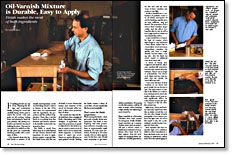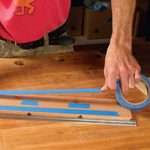Oil-Varnish Mixture is Durable, Easy to Apply
Finish makes the most of both ingredients
Synopsis: Putting on a finish is Garrett Hack’s least favorite element of woodworking, so he found a finish that gives him consistently satisfying results with a minimum of effort. He explains how to mix and apply this hybrid, a mix of oil, varnish and turpentine, and how to apply it. He’s partial to using spar varnish, and he explains the background on a variety of varnishes. He doesn’t get too scientific about proportions; he uses boiled linseed or tung oil, which he mixes with the varnish and thins with turpentine, and brushes it on and rubs it off. He adds a note about how to rejuvenate the finish and how he topcoats with beeswax.
Finishing just isn’t my cup of tea. Planning the design and construction details, picking the wood and carefully laying out the parts to match the wood’s color and grain are all exciting. Cutting joints and planing by hand are pure pleasure. But putting on a finish is my least favorite part of building furniture. That may be one reason I’ve settled on a finish that gives me consistently satisfying results with a minimum of effort.
I first learned about this hybrid finish—a mixture of oil, varnish and turpentine—at the woodworking school I went to in Boston in the late 1970s. Since then, I’ve experimented with the ingredients, the proportions and the method of application. These days, I use this finish on everything from fine furniture and kitchen cabinets to the handles on the tools I use around my farm.
The finish is mixed from either tung oil or boiled linseed oil and varnish, thinned with turpentine. It’s easy to apply, doesn’t require a special dustfree finish room and, like any oil finish, it won’t obscure the texture and character of the wood. Yet because of the varnish, it offers more protection than oil alone.
The varnish also helps the finish build faster than a straight oil finish, eliminating much of the drudgery of application. Because the proportion of varnish is relatively low, this finish is as easy to repair or renew as an oil finish. And it can be tinted with artist’s pigments or oil-based stains to match any wood. There’s no need to fill pores on open-grained woods: Sanding the finish creates a slurry of wood dust, oil and varnish that fills the pores beautifully.
Don’t sweat the finish proportions
When mixing this finish, I don’t get overly scientific about measurements. The finish is very forgiving, and many proportions will work. Generally, I mix them in approximately equal measures. If I want more protection, I’ll add up to 50% more varnish. If it’s too thick (and always for the first coat), I’ll add more turpentine to get better the few who still us e them. Some of these varnishes take weeks to cure fully.
From Fine Woodworking #122
For the full article, download the PDF below:
Fine Woodworking Recommended Products

Double Sided Tape

Stanley Powerlock 16-ft. tape measure

3M Blue Tape























Log in or create an account to post a comment.
Sign up Log in